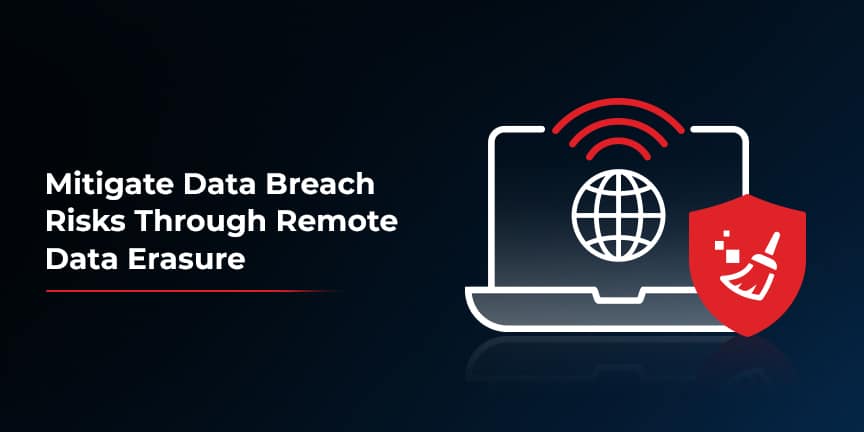Erase Data Remotely for Safeguarding Your Organization from Data Breach Risks
Remote data erasure enables organizations to securely erase data from endpoint devices used by the remote workforce to mitigate data breach risks.

Post-pandemic, there has been a significant rise in remote work arrangements. Forbes predicts that by 2025, around 32.6 million Americans will be actively engaged in remote work. This work culture transformation has amplified data security challenges for organizations to manage the data lifecycle from its creation to its disposal, especially for endpoint devices used by remote workforce. Compliance with data protection laws like CCPA, SOX, HIPAA, FACTA, and EU-GDPR is mandatory for organizations and is no longer a choice. Organizations must therefore adopt secure data sanitization methods that can help prevent data leakage and meet compliance, especially when an employee leaves the company, a project concludes, or when the data becomes obsolete.
Traditionally, organizations have relied on data destruction methods like shredding, degaussing, and on-premise data erasure to get rid of data. With the increase in remote workforce, organizations face unique challenges of data security where these traditional data destruction methods become inadequate. Let’s explore these conventional methods, why they fall short, and how remote data sanitization emerges as a powerful solution for organizations to mitigate data breach risks and remain compliant with laws and regulations.
Defining Traditional Data Destruction Methods
Data destruction is a process of getting rid of redundant, obsolete, and trivial data from storage devices permanently beyond the scope of recovery. Traditional Data Destruction methods can be broadly categorized into Physical and Logical methods. The Physical method of data destruction includes Shredding and Degaussing. While Shredding is an industrial technique to destroy IT equipment using a Shredder to render data irretrievable; Degaussing is a process of de-magnetizing the storage media for erasing data. The Logical method of data destruction, on the other hand, implies to a software-based Overwriting technique that replaces existing data with random characters (0s and 1s) using globally recognized algorithms. This technique is popularly called as ‘Data Wiping’ or ‘Data Erasure’ and helps make the device reusable.
The Pitfalls of Traditional Data Destruction Methods
** Physically destroying remote workers’ IT assets presents several challenges, making it an unsuitable choice for data destruction. Further, it requires specialized equipment and personnel, making it an impractical option. Additionally, there are environmental concerns associated with physically disposing of electronic devices, as they generate carbon footprints and cause irreversible environmental damage. SSDs, in particular, cannot be degaussed due to their technology, which stores data on a series of NAND chips rather than a magnetic platter. Most SSDs today are embedded on the motherboard, and in order to shred them physically, the complete laptop needs to be shredded, making the device redundant and adding to more e-waste. Moreover, shredding may not completely destroy data, leaving behind remnants that can be recovered using forensic tools in data recovery laboratories.
** Further, the traditional approach to performing logical data erasure by IT managers at remote workforce locations is also impractical. Organizations would need to send technicians or service providers to multiple locations where remote workers are deployed to sanitize IT assets. This solution is also intrusive to the privacy of remote workers. Additionally, if remote workers were to send their devices to the office premises or third-party location for performing data destruction, there could be chain of custody risks, potential data thefts, and device damages during transit leading to episodes of data leakage and breach. Organizations will have to deal with legal suits and incur penalties for data breaches.
Remote Data Erasure – The Wise Choice
Remote Data Erasure is a process of sanitizing endpoint devices using software at any internet-enabled location without physical access to the device, with minimal intervention. In this case, the IT admin can simply send the application to the remote worker’s machine and wipe data. By adopting ‘Remote Data Erasure’, organizations can effectively manage data destruction across distributed environments minimizing data security risks in a cost-effective way. Some benefits that remote erasure brings are listed below:
** Helps Mitigate Data Breach Risks: Remote data erasure allows organizations to sanitize any endpoint device across any location securely, eliminating the data breach risks due to sensitive data being compromised or leaked during transit. Organizations can mitigate data breach risks and prevent penalties imposed by lawsuits.
** Manage Simultaneous Erasure of Multiple Endpoint Devices: With remote data erasure, multiple laptops used by remote workers or contractors can be simultaneously wiped across locations. This streamlines the IT asset lifecycle management during mass layoffs, employee termination, or project completion, thereby closing the vulnerability window that traditional data destruction methods may leave open.
** Certified Data Wiping for Audit Purposes: Remote data wiping software generates secure and automated audit trails enabling organizations to demonstrate compliance with data protection regulations like CCPA, SOX, and EU-GDPR. By ensuring the complete and verified removal of sensitive data from remote workers, machine organizations can meet both statutory and regulatory compliances.
** Helps Organizations Meet ESG Goals: Remote data erasure facilitates device reuse and recycling, unlike physical methods of destruction. This helps the organization meet its Environmental, Social, and Governance (ESG) goals. Additionally, it allows companies to reduce their carbon footprint by reducing the amount of electronic waste that ends up in landfills or is incinerated, releasing harmful pollutants.
Conclusion: Mitigating Data Breach Risks with Remote Data Erasure
Remote data erasure provides organizations with a secure and convenient method of data sanitization, allowing permanent removal of data from endpoint devices assigned to the remote or hybrid workforce. This process ensures data privacy and compliance with regulations and helps mitigate the risk of data loss during transit. By using remote wiping software like BitRaser, which overwrites the media with globally approved algorithms, organizations can effectively erase data remotely from laptops and prevent unauthorized usage.
